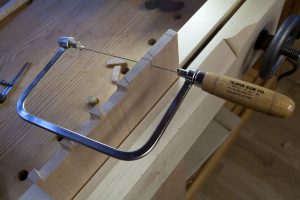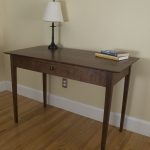We may receive a commission when you use our affiliate links. However, this does not impact our recommendations.
When cutting dovetails, I’ve always cleared out most of the waste with a coping saw. Why? I learned it that way in 1993 and am faster with the coping saw than I am with a chisel.
Even though I’ve been dovetailing for almost 20 years, I’m always looking for small things to improve my speed and tighten my fit. This morning while cutting the endless dovetails for this Campaign Secretary I had a thought.
This can be good at times, or a waste of a good time.
One of the annoying things about coping saw blades is that they have too much set. My much-beloved Olson blades are .015” thick but cut a kerf of .025” – that’s .005” of set to each side.
As a result of this extraneous set, it can be hard to drop the coping saw blade into the kerf left by my dovetail saw, which is .020”. The tips of the teeth stop me from dropping the blade to the bottom of the kerf and making an abrupt left turn to saw the waste. As a result, I have to saw out the waste in two sweeps, one left and one right.

This morning I filed back the set on my coping saw blade. I took about five swipes on each side of the blade with a fine mill file. After I finished, the thickness of the blade plus its teeth equaled .017”.
Then I went to work. The blade dropped to the bottom of my existing kerf and I was able to clear the waste of my pin board with only one sweep.
Doesn’t the saw jam without the set? Perhaps it would if I were cutting wet softwood, but in dry hardwood – mahogany in this case – the blade sailed right through without a squeak.
This got me thinking that perhaps I could try to bend out the set in a blade using a metalworking vise like Mike Wenzloff shows in this video I shot.
— Christopher Schwarz
Like Nerdy Hand-tool Talk?
I do. And that’s why I wrote “The Anarchist’s Tool Chest,” a book about the core set of about 50 tools you need to make a good start at handwork. After being out of stock, ShopWoodworking.com now has the third printing in stock and ready to ship. This third printing includes, at reader request, an index. Read more details here.
Here are some supplies and tools we find essential in our everyday work around the shop. We may receive a commission from sales referred by our links; however, we have carefully selected these products for their usefulness and quality.










I use a jeweler’s saw. It uses scroll saw blades. It has about 3″ of depth but that’s plenty for dovetails. I have stoned a few dovetail saws, though.
My grandfather used a similar technique to flatten the set on fine toothed saws, like coping saw blades. He would stone the blades. No, not with an heirloom Arkansas whetstone, but with a stone from the Licking River. Under magnification, a stoned, or draw filed, saw blade’s teeth kind of look like a Japanese-style saw’s teeth.
Just sayin…
Yes, smashing the teeth in a metalworking vise does take out most of the set.
I’m a total novice, so please forgive me a potentially stupid question about marking out dovetails. Has anyone ever tried this – let’s say you cut tails first. Make the vertical cuts for the tails, but before sawing or chopping out the waste, use the cut lines to guide your marking gauge to mark out the pins on the pin board. The marking gauge would have to be thin enough to fit in the kerf (maybe an XActo knife) and also tall enough (longer than the width of the tail board), but is there any reason this is a bad approach?
So, why are you back using the Olson coping saw? I thought you were wild about the vintage Millers Falls, or the Stanley?
Interesting… does it turn as easily as it did with the over-set teeth?
I just switched to using a fret saw myself. In part due to financial obligations. A new Titanium Knew Concepts fret saw with an Elkhead Tools cocobolo handle. It works swimmingly and I look good doing it !!!
TomS
I agree, the coping saws are hard to deal with considering the large teeth. I’ll take your advice and post back the results to let anyone interested know.
JS
That’s one of my biggest gripes with Coping Saws! I’ve been trying to move from a Fret Saw to a Coping Saw, but those wide teeth have been a pain. I’ll give this a try and maybe I can make the move now.
Mike